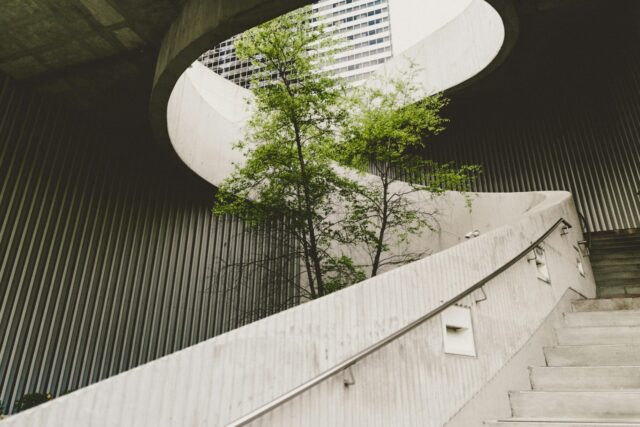In the past, terms such as ‘pollution,’ ‘ecology,’ and even ‘sustainability’ were not used or even known. Today, they are, which speaks to how our society has prioritized actions in favor of the environment.
In a world increasingly conscious of environmental impact, it is precisely sustainability that has become a key trend in all aspects of life, including the design and construction of sustainable stands.
For companies, whether small or large, riding this wave is key for several reasons, such as because it adds positive aspects. However, before we get to it, we will go deeper into the topic of sustainability and move forward with the stands.
Sustainability has become fashionable
It is undeniable that sustainability has become fashionable, mainly because people are increasingly aware of the urgency of addressing environmental issues. From plastic pollution to deforestation, the devastating effects of our actions are clearer than ever.
As a result, companies are being pressured in one way or another to adopt more environmentally friendly practices, and in this sense, sustainable stands are not only a way to reduce a company’s environmental impact but also an opportunity to communicate its values and commitments to its customers and society at large.
When it comes to events and exhibitions, sustainable booths are an excellent way to educate and raise awareness of the importance of sustainability. By showcasing tangible examples of green practices, companies can inspire others to follow suit and contribute to a more sustainable future for all.
Sustainability brought to eco-design
Eco-design is a philosophy that is gaining increasing popularity, as it seeks to minimize the environmental impact of a product throughout its life cycle. It is based on principles such as reduction of materials, use of renewable resources, optimization of transportation, and ease of disassembly and recycling.
These principles can and should be applied in the creation of exhibition stands to ensure that they are as sustainable as possible, making use of recycled or recyclable materials, such as cardboard, certified wood, and organic fabric, among others.
The modular design and the reuse of components allow the stands to adapt to different spaces and events, thus extending their useful life and reducing waste generation.
Basic principles to achieve eco-design
To achieve an effective eco-design in exhibition stands, it is important to follow some basic principles, as we will explain below:
- Minimize the use of materials. Try to use light and recyclable materials in the construction of the stand to reduce the consumption of natural resources and the generation of waste.
- Optimize transportation. It is always recommended that the stand be designed in a modular way to facilitate its transportation and reduce the associated carbon emissions.
- Prioritize energy efficiency. It is essential to incorporate energy-efficient lighting systems and use renewable energies whenever possible to reduce the environmental impact of the stand.
- Encourage reuse and recycling. Design the stand so that its components can be reused in future events or recycled at the end of their useful life.
Benefits of adopting an eco-designed stand
Adopting an eco-design approach to exhibition stand construction offers a number of benefits for both businesses and the environment:
- Reduced environmental impact. Ecological stands minimize the consumption of natural resources and waste generation, helping to preserve the environment for future generations.
- Differentiation from the competition. Companies that adopt sustainable practices can stand out in the marketplace and win the loyalty of customers who value commitment to the environment, of which there are an increasing number.
- Long-term cost savings. Although the initial construction of an ecological stand may require additional investment, in the long term, it will result in significant savings in terms of energy, materials, and transportation.
- Improved brand image. Appearing as a company committed to sustainability will make the reputation and perception of the brand more positive among consumers and the community at large.
Practical tips for eco-stand design
When designing sustainable exhibition stands, it is ideal that you keep in mind some practical tips to make them, such as the following that we will indicate:
- Research and select sustainable materials. Use recycled, recyclable, or sustainable materials in the construction of the stand because this will be the basis of a good design that generates the idea you are looking for.
- Optimize energy use. Energy-efficient LED lighting systems are recommended because, as we know, lights are key to attracting attention, and likewise, take advantage of natural light whenever possible.
- Design for reuse. Build the booth in a modular fashion so that its components can be reused in future events.
- Promote sustainable practices. Conduct the necessary education and awareness of staff on the importance of sustainability and how to minimize environmental impact during booth set-up and dismantling.
So… Are you going to adopt sustainable stands?
Sustainable exhibition stands are an excellent way to demonstrate a company’s commitment to environmental sustainability and promote more responsible business practices.
By adopting an eco-design approach and following basic sustainability principles, companies can create media that are not only visually appealing but also environmentally friendly.
Ultimately, this benefits the company in terms of brand image and competitive differentiation on the one hand, and on the other hand, it is great for the preservation of the planet for future generations.
If you prefer to have professionals take care of its creation to get the most out of it, you already know that at the beginning, we have recommended Pro Expo, whom to keep in mind for this task.
